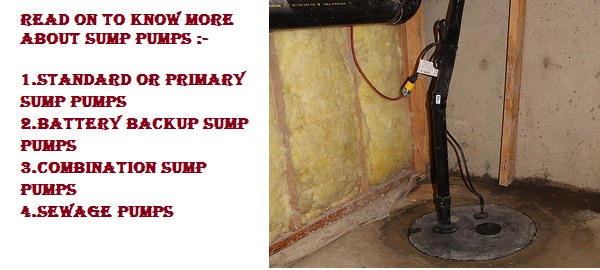If your house is one of the millions of homes in the United States with a basement, then you must have probably experienced the hassles and the stress that one has to go through with basement flooding. Sump pumps can be associated with like kickers on NFL teams, you only notice them when they don’t come through or start making noises.
If a sump pump fails, your basement can get flooded very badly and a valuable amount of investment can be ruined or damaged. In such a scenario, it is always better to get a professional plumbing company’s help, who can help you clear the basement flooding as well as to suggest tips to replace or repair sump pump.
If you are going to buy a sump pump, you first need to understand the as what are the types and kinds of sump pump available in the market. Read on to know more.
Standard or Primary Sump Pumps
Primary sump pumps are the standard pumps that are found in many residences across America. The basic job of this machine is to pump seepage water out of your basement, thus preventing floods. Primary pumps can pump up to several thousand gallons of water an hour to keep your home safe and dry.
Basically, there are two types of primary sump pumps, submersible and pedestal pumps. Submersible pumps are placed under water in your sump pump basin, while Pedestal pumps are positioned with the pump motor out of water and above your sump basin. They are good for small sinks, as the pump base is submerged, but the pump motor is not.
Battery Backup Sump Pumps
These pumps provide you added leverage in case the power goes out. As battery backup sump pumps are electric-powered, they can be rendered useless in a power outage, which is usually when you need them most.
The battery backup unit can only be used in the event of a blackout. When the power goes out, the battery unit kicks in providing the pump with power, so it continues working, even without regular electric power. Advancement in technology allows some of these pumps to even text or email you in the event of a failure.
Combination Sump Pumps
As the name suggests combination sump pumps are a mixture of a primary pump and a battery backup all in one package. If you have ever dealt with the aftermath of a flooded basement, you exactly know how painful that process of getting that water out can be. Never hesitate to call an emergency plumbing service if things go out of hand.
With a combination sump pump, you are always protected under normal circumstances and in situations of power outages as well. Besides flood insurance, this is a very handy machine in home flood protection. The backup pump also kicks on in the event, when the primary pump cannot keep up with the water as it enters the basin.
Sewage Pumps
Although not your traditional sump pumps, but sewage pumps could also be used for this purpose. More or less, sewage pumps are primarily designed to pump sewage waste and effluent from a home to a septic system present outside the house.
Sewage pumps are able to pass solids up to 2″, which is one major difference between them and regular sump pumps. Once installed, sewage pumps run automatically. They can either be installed in the septic tank itself, or in a separate pump chamber.
Always call a professional and local plumbing and sewer service company to help you out in times of emergencies. As a safety precaution, keep a timely checking and maintenance on all your home and office plumbing fixtures to avoid future adversities.

